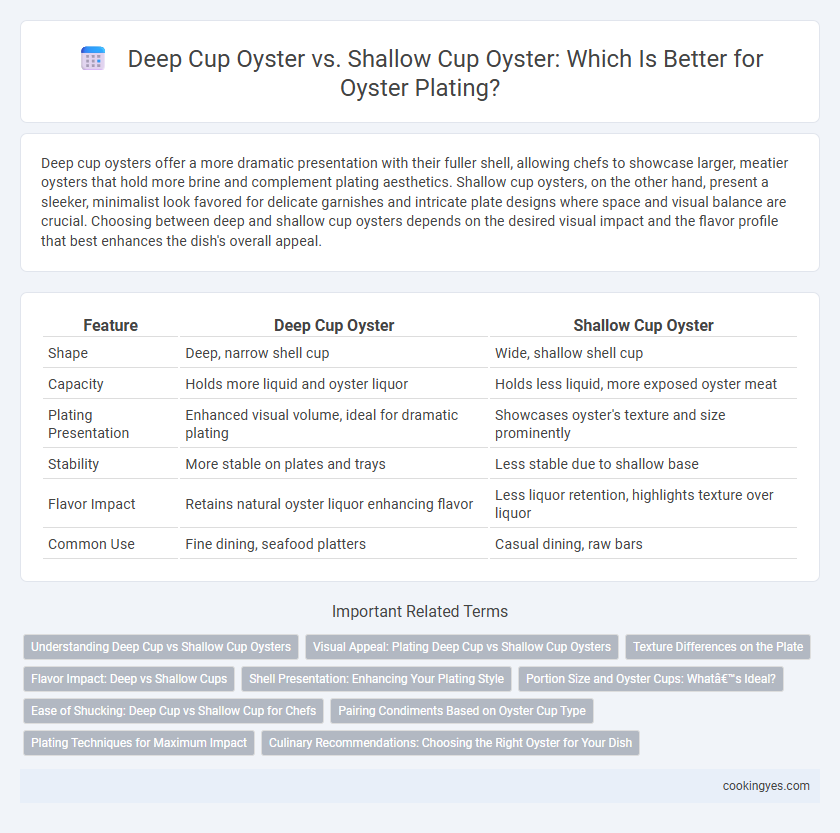Deep cup oysters offer a more dramatic presentation with their fuller shell, allowing chefs to showcase larger, meatier oysters that hold more brine and complement plating aesthetics. Shallow cup oysters, on the other hand, present a sleeker, minimalist look favored for delicate garnishes and intricate plate designs where space and visual balance are crucial. Choosing between deep and shallow cup oysters depends on the desired visual impact and the flavor profile that best enhances the dish's overall appeal.
Table of Comparison
| Feature | Deep Cup Oyster | Shallow Cup Oyster |
|---|---|---|
| Shape | Deep, narrow shell cup | Wide, shallow shell cup |
| Capacity | Holds more liquid and oyster liquor | Holds less liquid, more exposed oyster meat |
| Plating Presentation | Enhanced visual volume, ideal for dramatic plating | Showcases oyster's texture and size prominently |
| Stability | More stable on plates and trays | Less stable due to shallow base |
| Flavor Impact | Retains natural oyster liquor enhancing flavor | Less liquor retention, highlights texture over liquor |
| Common Use | Fine dining, seafood platters | Casual dining, raw bars |
Understanding Deep Cup vs Shallow Cup Oysters
Deep cup oysters feature a thicker, more rounded shell that holds a larger volume of liquor, making them ideal for plating as they maintain freshness and enhance presentation. Shallow cup oysters have a flatter shell with less liquor, often preferred for their easier shucking and delicate texture but may require quicker consumption to retain optimal flavor. Understanding the difference between deep cup and shallow cup oysters helps chefs select the right oyster based on visual appeal, flavor retention, and service style.
Visual Appeal: Plating Deep Cup vs Shallow Cup Oysters
Deep cup oysters create a striking presentation by cradling sauces and garnishes, maintaining a neat and elevated visual appeal that draws the eye. Shallow cup oysters offer a broader surface area, showcasing the oyster's texture and size more prominently, which enhances the plating's openness and simplicity. Selecting deep cup versus shallow cup oysters impacts the dish's overall aesthetic, balancing elegance with accessibility on the plate.
Texture Differences on the Plate
Deep cup oysters offer a firmer and meatier texture that holds up well during plating, providing a substantial bite and maintaining their juices. Shallow cup oysters present a more delicate and silky texture, allowing for a lighter, smoother mouthfeel that spreads easily on the palate. The choice between deep and shallow cup oysters significantly influences the overall dining experience, with texture playing a key role in complementing sauces and garnishes on the plate.
Flavor Impact: Deep vs Shallow Cups
Deep cup oysters retain briny, mineral-rich liquor that intensifies their savory, oceanic flavor, enhancing taste complexity on the palate. Shallow cup oysters present a cleaner, more delicate flavor profile with less liquor, allowing subtler sweetness and texture variations to shine in plating. Selecting deep or shallow cups significantly influences the balance of brininess and freshness, adjusting the overall flavor impact of oyster dishes.
Shell Presentation: Enhancing Your Plating Style
Deep cup oysters feature a concave shell that holds the oyster liquor perfectly, offering a luxurious presentation ideal for elegant plating styles. Shallow cup oysters display a flatter shell, allowing the oyster's texture and color to be more visible, enhancing visual appeal for modern, minimalist plating. Choosing between deep and shallow cups significantly influences the overall shell presentation, elevating the aesthetic and sensory dining experience.
Portion Size and Oyster Cups: What’s Ideal?
Deep cup oysters offer a larger portion size that holds more meat and brine, making them ideal for generous plating presentations, while shallow cup oysters provide a smaller, more delicate serving that complements minimalist plating styles. When selecting oyster cups, it's essential to consider the cup depth relative to the oyster size to ensure stability and enhance the visual appeal of the dish. Optimal portioning balances the oyster meat volume with the cup design, enhancing both flavor delivery and overall dining experience.
Ease of Shucking: Deep Cup vs Shallow Cup for Chefs
Deep cup oysters require more effort to shuck due to their thicker shells and deeper hinge, offering chefs a more secure grip but demanding greater skill and time. Shallow cup oysters feature thinner shells and a flatter hinge, making them easier and faster to shuck, which enhances efficiency during high-volume plating. Choosing between deep and shallow cup oysters depends on the balance between presentation preference and operational speed in restaurant kitchens.
Pairing Condiments Based on Oyster Cup Type
Deep cup oysters hold robust, briny flavors that pair excellently with tart, acidic condiments like mignonette sauce or citrus-based dressings, which enhance their rich texture. Shallow cup oysters, offering a lighter, more delicate taste, complement sweeter or herbaceous pairings such as cucumber relish or fresh herbs, balancing their subtle profile. Selecting condiments based on oyster cup depth optimizes flavor harmony and presentation on the plate for a refined dining experience.
Plating Techniques for Maximum Impact
Deep cup oysters offer a natural vessel to hold sauces and garnishes, enhancing visual appeal and flavor concentration, while shallow cup oysters provide a broader surface ideal for intricate plating designs that showcase garnish arrangement. Placing microgreens or caviar centrally on deep cups maximizes depth contrast, whereas shallow cups benefit from layered toppings to create textural variation. Optimal plating combines oyster type with complementary ingredients to elevate both aesthetics and taste for an impressive presentation.
Culinary Recommendations: Choosing the Right Oyster for Your Dish
Deep cup oysters hold more liquor, making them ideal for raw presentations where briny, flavorful juice enhances the tasting experience. Shallow cup oysters offer a more delicate texture and are better suited for cooking methods like grilling or baking, where the meat's subtle sweetness stands out. Selecting between deep and shallow cup oysters depends on the dish's flavor profile and preparation style to maximize taste and presentation.
Deep Cup Oyster vs Shallow Cup Oyster for Plating Infographic

 cookingyes.com
cookingyes.com